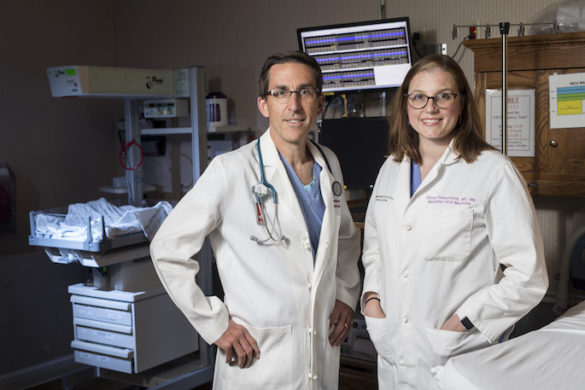Most women who undergo a cesarean section are sent home with more opioids than they need, but a significant proportion of women use all opioids and report unmet pain needs, according to Sarah Osmundson, MD, MS, assistant professor of Obstetrics and Gynecology.

Armed with a new five-year grant from the National Institute on Drug Abuse, Osmundson and colleagues are developing a clinical decision support tool to help predict individualized opioid needs based on patients’ clinical, demographic and behavioral characteristics, avoiding issues associated with both over- and under-prescribing.
Almost one-third of women undergoing childbirth in the U.S. will have a cesarean.
“We know that unused opioids exist in the community and provide a source for other people to use and misuse, but we also don’t want to undertreat pain after surgery,” said Osmundson.
“We can decrease the number of tablets prescribed or send patients home with nothing, but at some point, it may tip in terms of unhappy patients, adverse outcomes and unmet pain needs.”
The three-part study will first collect data on how many opioids patients are using by conducting follow-up phone calls two weeks after discharge.
As an added confirmation to patient reports of how many opioids are left, the prescription will be sent home in a bottle with a Bluetooth-enabled cap that records each time the bottle is opened and closed, counting the times a tablet is removed.
Patients will also receive a Bluetooth-enabled bottle of ibuprofen to determine how patterns of over-the-counter pain medication use influence opioid use.
The data will be used to identify factors associated with minimal or maximal opioid use, which will then be built into the clinical support tool to calculate custom opioid needs, providing a recommended number of tablets.
Eventually, the tool will be built into Epic — the Medical Center’s electronic health record — so the data can be pulled from the patient’s chart and so the model can be transferred to other institutions.
The third phase of the study will test the clinical support tool against standard practices in a randomized clinical trial.
Previous research by Osmundson showed that opioid prescribing appears to be based on prescriber habits rather than patient needs, with many prescribers sending women home with a 30-tablet prescription regardless of their pain.
“I think some physicians have their own standard they’re used to prescribing or they tend to repeat what they learned in residency or from their superiors. We do a lot of prescribing that’s based on even or round numbers, like tens and fives. I think few physicians look at how much a patient has used in the hospital to make a decision,” said Osmundson, who noted it can be cumbersome for providers to review an entire inpatient record to see what was used.
“The goal of a clinical support tool is to do that work for the providers. It’s not feasible for a provider to count previous usage when they have 10 patients to see in one morning, so that’s when they default back to 30 tablets.”
Prior research has also shown that women who are sent home with more opioids tend to use more.
A smaller-scale study of custom prescribing for postpartum women found that women used roughly two-thirds of their prescription regardless of how many tablets they received at discharge.
“There’s a lot of literature on portion sizes and eating habits, and I think this may be similar for what you’re given in terms of opioids,” said Osmundson.
The researchers hope to use cesarean sections as an example of post-surgical opioid prescribing after hospital discharge — an issue that has received less attention than opioids related to chronic pain.















